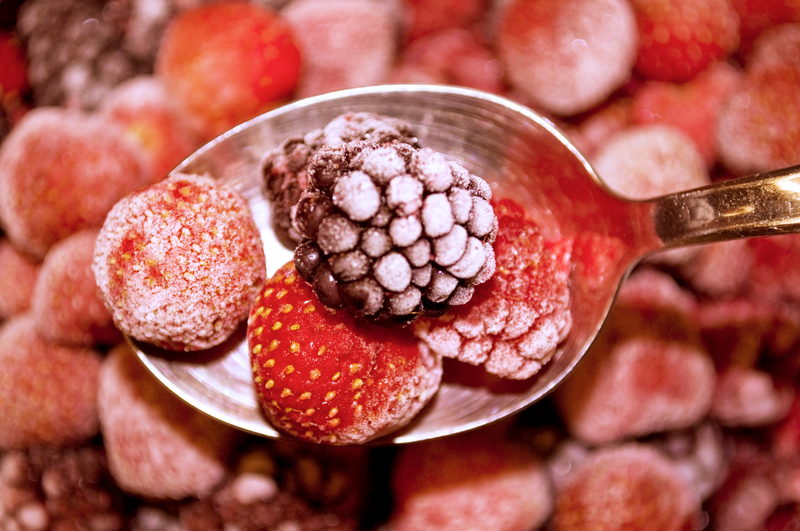So, you bought too many packages of fresh berries and bananas than you could eat before they go bad. Your avocados are ripening faster than you can eat them. There was a special on mangoes that was too good to pass up. Instead of throwing out fruit that has past its ideal freshness, why not preserve them for future use. An easy way to preserve these and more fruits is to freeze them. The freezer is one of the least utilized appliances in your kitchen. Freezing excess food is a great way to reduce food waste, save you some money and trips to the grocery store.
Freezing fruit alters the texture a bit but it’s the best way to preserve the flavor and sweetness for future consumption. You can use frozen berries, bananas, pineapple and avocados in smoothies, stir some blueberries in yogurt or make them a topping with your almond flour pancakes. Frozen bananas, grapes and honeydew melon are an awesome treat straight out of the freezer.
And, yes, you can freeze avocados! Avocados can be expensive and if you don’t eat them before they go bad, you are wasting hard-earned money. Freezing is a great way to preserve them before they turn brown. Frozen avocados as best used in smoothies, guacamole or smashed for your avocado toast. They don’t hold up well enough for slicing for salads and sandwiches.
Here’s a simple guide that will allow you to freeze almost any fruit. Most fruits freeze well depending on the its water content and structure. One key thing to remember is that moisture and air are the enemy of frozen foods. Watermelon and citrus slices do not freeze well but you can juice or zest the citrus and freeze that.
How to Freeze Fruits
- Choose fruits that are ripe and unblemished.
- Wash and sort for damaged fruit before freezing. Dry by gently blotting with a towel or paper towel or air dry.
- If the fruit has a skin, peel it. Carve away any bruises, gashes or other undesirable spots.
- If your fruit is larger than bite-sized, cut or slice it into uniform-sized pieces.
- Pat your fruit dry again. Try to remove as much moisture as possible.
- Transfer fruit to a sheet pan or cookie sheet covered with parchment paper or a silicone baking mat. Spread fruit into a single layer. Cover with plastic wrap and transfer the tray to the freezer and freeze for a few hours or up to overnight. Tip: before you load your fruit onto the tray, make sure the tray fits in your freezer!
- Remove tray from freezer. Gently peel fruit off the parchment paper or silicone mat and transfer to a labeled freezer bag. Press as much air as possible out of the freezer bag before sealing.
- Your fruit is not ready to go back into the freezer and will last for 6 to 9 months.
Fruits that are well suited for freezing:
Apples: Sweet apples tend to hold their flavor better than tart varieties. Peel skins and slice before freezing. To prevent browning of the apples, brush with a small amount of lemon juice.
Bananas: Peel and slice before freezing.
Berries: Wash blackberries, blueberries, raspberries or strawberries (stem if necessary) and dry thoroughly before freezing whole. (Strawberries can be sliced, as well).
Citrus: It is best to zest and juice and freeze separately. Juice the oranges, lemons, limes or grapefruit and transfer juice to an ice cube tray. You can zest the citrus rinds directly into a freezer bag or divide into single serving portions (such as teaspoons or tablespoons) for convenience.
Kiwi: Peel and slice before freezing
Mangoes: Peel and cut into chunks before freezing.
Melons: Cantaloupe and honeydew freeze well unlike watermelon due to its high-water content. Peel, deseed melon and cut into chunks before freezing
Pineapple: Peel and core before slicing and cutting into chunks, then freeze. Tip: If the pineapple is particularly ripe, save the leftover juice and freeze that too.
Stone fruit: Peel peaches and plums before slicing and freezing. Apricots do not require peeling. Cherries should be pitted before freezing. Tip: An easy way to help you peel peaches and plums is to score an “X” on the bottom (skin only) with a paring knife. Gently place the fruit into boiling water until the skin starts to loosen around the score mark, about 30 to 40 seconds. Place in a bowl containing ice water to stop the cooking. The peel should now be able to be pulled away with your fingers.
How to Freeze Avocado Halves
- Wash avocados before cutting.
- Slice the avocado in half, seed and scoop the half out of the peel using a spoon. Brush the halves with a bit of lemon juice and wrap them tightly in plastic wrap. Do not leave any room for air including covering the curve where the seed was.
- Place wrapped avocado halves into a large labeled freezer bag. Press out as much air as possible before zipping the bag closed. Place the bags with the halves in the freezer.
- Remove each one whenever you are ready to use it, let it thaw and enjoy!
Bonus: Prep is even easier if you have a food prep or vacuum sealing machine that pulls air out of the seal. If you do this, you can skip wrapping the avocados in plastic wrap.
How to Freeze Mashed Avocados
- Place scooped avocados into a bowl and drizzle with juice of half a lemon of 2 teaspoons of store-bought lemon juice.
- Mash the avocado to your preferred texture.
- Place in zipper-sealed freezer bag. Remove as much of the air as possible and put in freezer. Tip: you can make smaller portions by using a gallon-size bag, lay flat and fold in half before placing in the freezer.
For 1:1 nutritional support, set up a telemedicine appointment today!
Schedule
Please fill out the form to request an appointment at our health and wellness center for the service and location of your preference. We try to get back to all requests as quickly as possible. If you need immediate assistance, please call 773-598-4387.
Your safety comes first: we are operating with heightened safety measures in our clinics and offer telemedicine for those unable to visit in person.









